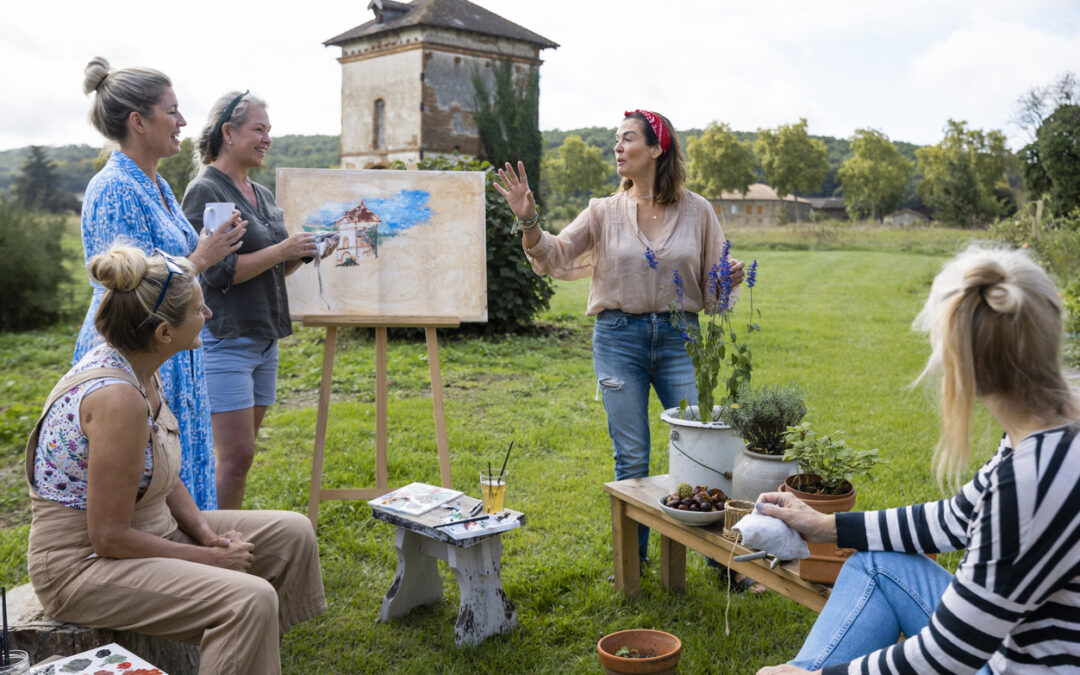I’ve claimed 2024 as my year of Playful Creativity. How about you? Do you have a word or phrase for this new year?
In “Learning to Dance with Life”, I identified seven keys to what I call “Creative Living”. Seven keys to consciously cultivating improved health, happiness, fulfillment and inner peace in your life. Who doesn’t want that? One of the seven keys is “Tap into and express your creative side.”
Why is creativity so important?
- When we consciously bring creativity into our lives it connects us with our inner child; that part of us that loves to laugh and comes from a place of wonder
- When we engage in creative pursuits such as singing, painting, dancing, gardening, writing, drawing, it is therapeutic. We can get lost in the creative process and at that time forget all the challenges facing the world or the stressful parts of our own lives, and instead focus on feeling light and passionate about what we are creating.
- When we create, we are totally in the NOW[1]. That is the space when we can tap into our inner wisdom, and also feel a sense of freedom and awareness; appreciating all that we have, and all that we are.
- There is much data to support the health and healing benefits of the arts
- Now, more than ever, we need creative solutions to solve the complex issues facing us such as climate change and systemic racism.
What are some ways to tap into and express your creativity?
Here are a few examples from “Learning to Dance with Life”.
Sit down in a quiet place, free from distractions. Take a few deep breaths to relax and close your eyes for a couple of minutes if you feel comfortable doing so. Ask yourself the following questions and write down your responses to them. Write down the first thing that comes to mind without judging or editing it.
- Do you consider yourself a creative person? If yes, why? If not, why not?
- Are there any creative pursuits you enjoyed as a child but haven’t done for years? If so, what are they?
- Are there some creative or artistic pursuits you would be interested in exploring/trying out?
- Commit to either starting to integrate a childhood “passion” into your life or choose a new one such as “learning to play the piano” that perhaps you always wanted to do as a child but never had the opportunity to do. Identify the next steps for taking action to integrate a new or “old” creative or artistic pursuit into your life. It’s helpful to use a two-column table with “activity” heading one column and “timeline” the other. For example:
- Activity: Explore online and via word-of-mouth “good” teachers offering piano lessons in my area. … Timeline: Start tomorrow (January 10, 2024)
- Activity: Begin piano lessons … Timeline: Start first lesson by January 29/24.
- Support is important to many of us when starting something new and continuing with it. Enlist the support of a friend, colleague or family member to encourage and support you in your new endeavor or invite them to join you in doing it.
Observations and Insights from engaging in artistic/creative pursuits.
- After you have engaged in a creative/artistic pursuit, go into your body and note how you feel. Does your body feel lighter? Do you have more energy? Is your mind quieter?
- When you engage in a creative/artistic pursuit over time what changes if any do you notice in your body? Mind? Emotions? Relations? Life in general?
- If you have been engaging in a creative/artistic pursuit with a friend, colleague or family member, what changes, if any, do you notice in them?
The Importance of Play and Laughter
Creativity is connected to play and laughter. There is much evidence to support the importance of play and laughter in our daily lives. Stuart Brown, founder of the National Institute for Play[2] has conducted research that shows that play is not only energizing and fun, but also important for human physical, emotional, cognitive development and intelligence.
“Play activates the reward centers of the brain, floods the rest of the brain with feel-good chemicals like dopamine and oxytocin and triggers the release of powerful neural growth factors that promote learning and mental flexibility. It causes stress hormones to drop, mood to lift and has an energizing effect.” [3]
Integrating Play and Laughter into our lives
Playing imaginary and other games with my young grandchildren has been a fun and easy way to integrate play and laughter into my life.
Here are a few other examples of how to integrate play and laughter into your life.
- Identify and write down types of play activities you enjoyed and engaged in as a child.
- Reflect on how many of these activities you currently engage in as an adult and how often you engage in them.
- Rate on a scale of 1 to 10 how energized each of the above activities makes you feel – 1 being “not at all” and 10 being “full of energy”.
- Identify several play activities you would like to begin integrating into your life. Experiment and notice how they make you feel.
- Commit to engaging in some form of play or laughter on a daily basis. Ask friends and family for support (perhaps make it a family project to laugh and play at least once a day) and encourage play and laughter in their lives as well.
I encourage you to try out some of the exercises shared and consciously integrate more creative pursuits and more play and laughter into your life. And notice what you notice.
I welcome your thoughts and experiences below.
[1] Eckhart Tolle, The Power of Now: A Guide to Spiritual Enlightenment, New World Library, 2004
[3] https://www.newsweek.com/2023/07/28/do-you-play-enough-science-says-its-critical-your-health-well-being-1813808.html
